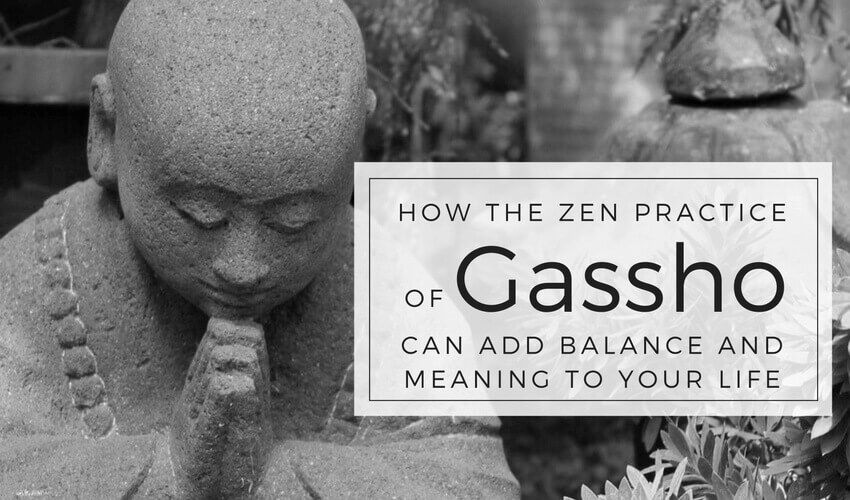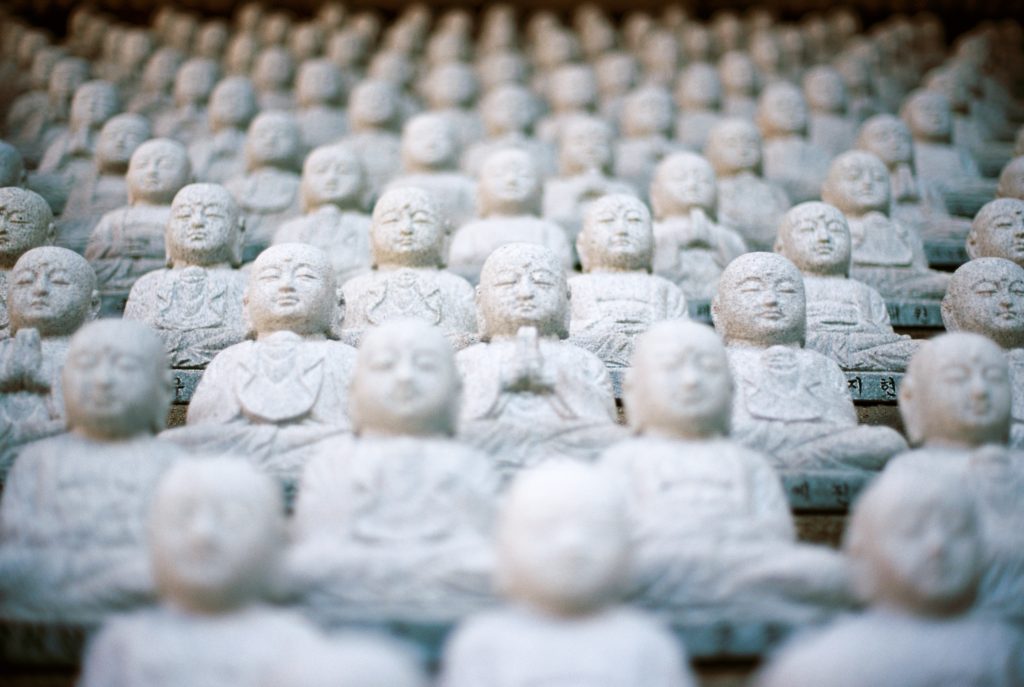
How the Zen Practice of Gassho Can Add Balance and Meaning to Your Life
In 1893, the Western world received the incredible teaching of Zen.
It was then that Rinzai Zen master Soyen Shaku, who is recognized as the first Zen Buddhist priest to come to the United States, was invited to and participated in the World Parliament of Religions in Chicago.
In the decades following that fateful trip, we would have the pleasure of welcoming several great Zen masters from Japan, including D.T. Suzuki and Shunryu Suzuki (no relation), author of Zen Mind, Beginner’s Mind.
Since then, we’ve received several amazing gifts from the practice and tradition of Zen and many have taken quickly to this beautiful practice including, most notably, the late Apple co-founder Steve Jobs.
However, there was a time when Zen first arrived on the shores of Japan in much the same way. The practice, which was said to be founded by Bodhidharma, a red-haired Buddhist monk traveling from India in the lineage of the original Buddha–more than 2,000 years ago in China, brought many valuable gifts then as well.
Zen quickly took foot in Japan, and over the next thousand years it would have such a significant impact on Japanese culture that aspects of its culture would become indecipherable from Zen in much the same way as Hinduism is rooted in Indian culture (or, rather, is in many ways Indian culture) today.
From art to philosophy, style, and the origins of the Japanese tea ceremony, Zen made an indelible mark on Japan that can still be witnessed today, albeit less significantly (for more information on Zen’s impact on Japanese culture, read D.T. Suzuki’s An Introduction to Zen Buddhism).
One of the more subtle gifts was the Zen practice of gassho, a part of a broadly Asian tradition of bowing, but distinct in its own right when practiced in the spirit of Zen.
What is Gassho?
Gassho, a ritual gesture where the practitioner presses one’s hands together in front of their chest as a sign of greeting or reverence (resembling praying and similar to the Indian practice of namaste), is a gesture with great significance in Zen practice.
How Does Gassho Relate to Zen and Buddhism?
Zen didn’t invent the gesture, as the hands-together bow is used throughout Asia in countries such as China, Japan, Vietnam, Thailand, and India. However, the practice took on a different significance once Zen began spreading throughout Japan in the 8th century CE.
Whereas gassho in its traditional sense was an act of greeting, apology, or reverence for another, gassho in Zen is about showing respect and reverence for life and serves as an act of humility where one can practice letting of the ego. In this way, gassho in Zen is a powerful practice which allows the practitioner to deeply touch their own spirit and that of the world around them.
The great Zen master Thich Nhat Hanh said this of the significance of the practice:
“Bowing is a deep form of communication. A bow may mean hello, thank you, good-bye, or excuse me. But it’s not just a way to be polite. It’s a way of recognizing and honoring the Buddha or the awakened nature in each of us. We bring our palms together carefully to form a beautiful lotus flower at the level of our heart. Then we look at the eyes of the person we will bow to and we smile.
We say silently, “A lotus for you,” as we breathe in and, “A Buddha to be!” as we breathe out and bow from our waist. Then we straighten up, look at the eyes of the other person, and smile. Isn’t that an easy gift to give someone?”
Respect and reverence for life is a core principle of Zen practice and something which is symbolized in the act of gassho. In Zen, practitioners bow to everything, everyone, and for almost every occasion.
The practice is a constant declaration of reverence for the world as a whole. When you enter the Zendo (a Zen meditation hall within a Zen center or monastery), you bow. When you enter the lecture hall, you bow. When you arrive in front of your zafu (a Zen meditation pillow) for meditation, you bow. Wherever you go, and whatever you do, you gassho.
The Zen practice of gassho is, in a way, an affirmation. An affirmation of your commitment to respect and care for the world around you in the same way that you would care for yourself. It serves then as an opportunity for more deeply connecting with the world around you, thereby nourishing you in the process.

Stay In Touch With Being Zen
How to use Gassho to bring balance and meaning to your daily life
While we’ve received many great gifts from the practice of Zen in the Western world, the practice of gassho and gassho rei (which is gassho with a small bow added in) wasn’t and likely won’t ever be one of them.
The practice of bowing is something which doesn’t come naturally to the ego-centric Western mentality, which sees bowing as a foreign and submissive act. Unfortunately, this misunderstanding prevents most of us in the West from ever learning about this beautiful practice.
However, that doesn’t mean you can’t make the practice available to you in your own daily life.
Gassho is a simple habit which can be used by anyone with a little practice, and, if you’re from the West like I am, a little getting used to.
Even a simple, slow nod with the head and neck without the hands pressed together, the kind not uncommon to see from someone as a form of acknowledgment in Western culture, can be used in place of a full bow if you’re worried about looking odd in front of others. You can then use that practice as a starting point or simply leave it at that.
What is most important about the practice of gassho is the meaning you assign it. You could be shaking your leg and, provided you’re doing the same mental exercise, it would have the same meaning. For that reason, don’t place as much focus on the physical movement as you do the exercise itself.
Here are three steps for a simple gassho practice which you can implement into your everyday life to add balance and meaning:
1. Decide when to gassho
If you’re just starting out with the practice, you might at first be confused about exactly when to gassho. Are there specific rules? Is there some method to the madness? If Zen practitioners bow every time they enter and exit a room, do I have to do the same?
Keep in mind that throughout these steps, there are no specific rules. These just suggestions to simplify the practice for modern life.
To that end, you decide when to do your gassho. My suggestion is to pick one specific occasion where you’ll gassho and try that out for a week or two. Keep it really simple and don’t overcomplicate things or you’ll never stick to it.
This can be:
- When you enter and exit your home
- When you meet and leave someone’s presence
- When you sit down to eat and get up from your meal
- Or a simple bow when you get up in the morning and lie down at night
Whatever occasion you pick, try your best to stick to it. Because it’s something entirely new, it will take time before you get the hang of the practice. Even if it only takes a few seconds to perform.
2. Enter the right state of mind
When it comes time to perform your simple gassho, there are only a few things you need to know.
The first is this: before placing your hands together and bowing (or whatever simple movement you’ve decided on) place yourself in the right state of mind. Take a second to quickly turn inward, take in your surroundings, and become mindful of your physical body.
This should only take you a second or two with practice as you don’t want to complicate the movement. The more complicated you make it the less likely you are to continue the practice as time goes on.
Why do this? The act of gassho is a deep gesture and you want to make sure you can touch deeply the feelings of reverence, respect, and love you’re attempting to cultivate through the practice.
With how hectic daily life is for most of us, in order to truly practice gassho correctly we must stop body and mind so that we can enter the right state of mind to perform it. If we don’t, we’ll be liable to rush through it and, while physically it may appear that we’ve done it, we won’t have actually touched deeply those feelings of reverence and love.
3. Gassho
Now that you’ve placed yourself in the right state of mind, simply perform your gassho.
When placing your hands together, or whatever movement you’ve chosen to perform, reflect on feelings of love and reverence for all life for a few moments as you do the movement from beginning to end. Feel connected to the Earth from your feet and remind yourself of your interconnectedness.
How To Do a Gassho
Each time the practice may feel a little bit different. Each time the feeling might be a little bit stronger or weaker than the next. This is perfectly normal and expected to happen, so don’t think you’ve done anything wrong. Any moment of introspection often uncovers unexpected results from the mind.
Once you’re done performing your gassho, it can be beneficial to take a deep, mindful breath to quickly reflect on the feelings you’ve just generated and cap off the exercise, bringing you back to the world.
Keep in mind, this entire movement from beginning to end takes just a few seconds, so it will take some time to get used to. However, the power of a gassho practice, done consistently and in conjunction with other mindfulness exercises, can’t be understated.

Conclusion
The Zen practice of gassho is a deceptively simple practice with great significance.
Whether you adopt a traditional gassho practice or use a simple nod with the accompanying mental exercise, this quick and easy practice can help add greater balance, meaning, and appreciation to your everyday life.
Other Posts You Might Enjoy:
5 Mindfulness Exercises To Realize Peace In Everyday Life
The Daily Remembrances Of The Buddha
Finding A Meditation Routine That Works